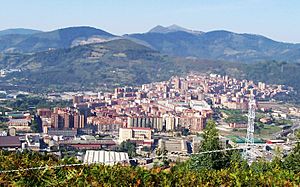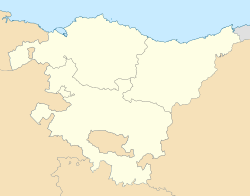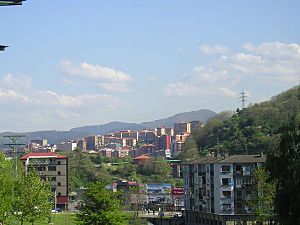Basauri facts for kids
Quick facts for kids
Basauri
|
|||
|---|---|---|---|
 |
|||
|
|||
| Country | |||
| Autonomous community | |||
| Province | Biscay | ||
| Comarca | Greater Bilbao | ||
| Founded | 1510 | ||
| Government | |||
| • Type | Mayor-Council | ||
| Area | |||
| • Municipality | 7.01 km2 (2.71 sq mi) | ||
| Population
(2018)
|
|||
| • Municipality | 40,762 | ||
| • Density | 5,815/km2 (15,060/sq mi) | ||
| • Metro | 910,578 | ||
| Demonym(s) | Basauritarra | ||
| Time zone | UTC+1 (CET) | ||
| • Summer (DST) | UTC+2 (CEST) | ||
| Postal code |
48970
|
||
| Dialing code | +34 94 | ||
| Official language(s) | Basque, Spanish | ||
Basauri is a town in northern Spain. It is located in the Basque Country. Basauri is part of the larger city area called Greater Bilbao. It is just a few kilometers south of Bilbao itself.
Basauri is known as an industrial town. You can find interesting old buildings here, like the tower-house of Ariz. The town is home to about 40,589 people (as of 2019).
Contents
Exploring Basauri's Location
Basauri is found in the Greater Bilbao area. It sits on both sides of the Nervión river. It is also in the lower valley where the Nervión and Ibaizabal rivers meet. These two important rivers of Biscay join in Basauri. This creates a small flat area.
The land in Basauri slowly rises from the river area. It reaches its highest point at Malmasín mountain (361 meters high). This mountain is made of clay.
Which Towns Border Basauri?
Basauri shares its borders with several other towns.
- To the north, it borders Bilbao, Etxebarri, and Galdakao.
- To the south and west, it borders Arrigorriaga.
- To the east, it borders Galdakao and Zaratamo.
Basauri's Neighbourhoods
Basauri is made up of many different neighbourhoods. Some of the main ones include:
- Abaroa
- Ariz
- Arizgoiti (which is the main part of town)
- Atxikorre
- Atxukarro
- Artunduaga
- Azbarren
- Basozelai
- Benta (Arizgain)
- Bidebieta
- Bizkotzalde (Beaskoetxealde)
- Errekalde
- Finaga (Pinaga)
- Ibarguen
- Ibarre
- Kalero (Kareaga)
- Matadero (Gaztañabaltza)
- Luzarre
- Pozokoetxe
- San Miguel (Elexalde)
- Sarratu
- Soloarte
- Solobarria
- Ugarte
- Uribarri
- Urbi
- Uriarte
- Zabalandi
Basauri's Climate
Basauri has an oceanic climate. This means it is generally warm and humid. Rain falls throughout the year, so there isn't one very rainy season. Temperatures stay mild all year, without big changes between seasons.
| Climate data for Basauri | |||||||||||||
|---|---|---|---|---|---|---|---|---|---|---|---|---|---|
| Month | Jan | Feb | Mar | Apr | May | Jun | Jul | Aug | Sep | Oct | Nov | Dec | Year |
| Mean daily maximum °C (°F) | 13.2 (55.8) |
14.5 (58.1) |
15.9 (60.6) |
16.8 (62.2) |
20.1 (68.2) |
22.6 (72.7) |
25.2 (77.4) |
25.5 (77.9) |
24.4 (75.9) |
20.8 (69.4) |
16.4 (61.5) |
14.0 (57.2) |
19.1 (66.4) |
| Daily mean °C (°F) | 9.0 (48.2) |
9.8 (49.6) |
10.8 (51.4) |
11.9 (53.4) |
15.1 (59.2) |
17.6 (63.7) |
20.0 (68.0) |
20.3 (68.5) |
18.8 (65.8) |
15.8 (60.4) |
12.0 (53.6) |
10.0 (50.0) |
14.3 (57.7) |
| Mean daily minimum °C (°F) | 4.7 (40.5) |
5.1 (41.2) |
5.7 (42.3) |
7.1 (44.8) |
10.1 (50.2) |
12.6 (54.7) |
14.8 (58.6) |
15.2 (59.4) |
13.2 (55.8) |
10.8 (51.4) |
7.6 (45.7) |
6.0 (42.8) |
9.4 (48.9) |
| Average precipitation mm (inches) | 126 (5.0) |
97 (3.8) |
94 (3.7) |
124 (4.9) |
90 (3.5) |
64 (2.5) |
62 (2.4) |
82 (3.2) |
74 (2.9) |
121 (4.8) |
141 (5.6) |
116 (4.6) |
1,195 (47.0) |
| Average precipitation days | 13 | 11 | 11 | 13 | 12 | 8 | 7 | 8 | 9 | 11 | 12 | 12 | 128 |
| Mean monthly sunshine hours | 86 | 97 | 128 | 128 | 160 | 173 | 188 | 179 | 157 | 123 | 93 | 78 | 1,584 |
| Source: Agencia Estatal de Meteorología, Aena | |||||||||||||
Basauri's Population Story
Basauri grew a lot in the 20th century. Being a place where many roads met helped it grow. Its closeness to mines also brought more people. Old mills turning into bakeries also added to the population.
But the biggest reason for growth was a large factory called "La Basconia". It opened in 1892. This factory brought many jobs.
The town's population grew very quickly. Between 1900 and 1975, it multiplied by almost 25 times! The biggest jumps happened in the 1950s and 1960s. New industries opened, and the population almost doubled in just ten years.
Here's how Basauri's population changed over the years:
| Year | 1900 | 1910 | 1920 | 1930 | 1940 | 1950 | 1960 | 1970 | 1980 | 1990 | 2000 | 2001 | 2003 | 2007 | 2009 | 2012 |
| Inhabitants | 1,989 | 3,456 | 5,194 | 9,444 | 10,405 | 11,626 | 22,991 | 41,558 | 55,648 | 50,940 | 47,376 | 46,669 | 45,346 | 43,250 | 42,657 | 41,971 |
After 1979, Basauri's population slowly started to decrease. This was partly due to an industrial crisis. The highest population ever recorded was 55,648 people. In 2007, about 43,250 people lived in Basauri.
Basauri's History
Basauri became its own town, separate from Arrigorriaga, in 1510. This is the official date, even though there's no exact document from that day. Basauri didn't get its own voice in the General Assembly of Guernica until 1858.
For a long time, the town hall was in the San Miguel de Basauri neighbourhood. But in 1902, it moved to Arizgoiti. This area was growing fast and was easier to reach from all parts of Basauri.
Until the late 1800s, Basauri was mostly a farming area. People grew corn and raised cattle and sheep. There were also some flour mills. Then, the Basconia factory arrived. This brought a lot of industry to the town. In just 50 years, Basauri grew from a few thousand people to 55,000 by 1978. Thousands of families moved here from all over Spain. This completely changed the town's look and buildings.
What Does "Basauri" Mean?
The name Basauri means 'population in the forest'. It comes from two Basque words: Basa (from Basoa), meaning 'forest', and uri (a version of Hiri), meaning 'population' or 'town'. There's another town with a similar name, Bajauri, in the County of Treviño.
Many places and neighbourhoods in Basauri have interesting names. For example, Bidebieta means 'two paths'. This name came from a place where two important roads met. The area now called Kalero used to have limestone kilns. These were used to make lime. So, 'Calero' simply means 'lime kiln worker' or 'lime place' in Spanish.
Fun Festivities in Basauri
The biggest celebrations in Basauri are the San Fausto festivities. These happen every October 13th. They are the town's main patron saint festivals.
Here are some of Basauri's other festivities:
| Festivity | Location | Date |
| San Isidro | Benta | May 15 |
| San Martin Finaga | Finaga | May 21 |
| St. John | Pozokoetxe, Basozelai | June 24 |
| - | Kalero | first weekend of September |
| San Miguel | San Miguel | September 29 |
| San Fausto (patron saint) | Basauri | October 13 |
Almost every major neighbourhood in Basauri has its own yearly celebrations. But the San Fausto festivals are the most famous. During these festivals, people use an amulet called the Escarabillera. They also drink a special drink called zurracapote. This drink is like sangria. It's made with red wine, lemon, cinnamon, a type of liquor, and sugar. Local groups called Herriko Taldeak prepare it and share it with everyone.
The Escarabillera is a special character. It represents the people of Basauri who, a long time ago, would search for coal. They would find coal along train tracks or near factories. They used this coal for cooking and even for paving streets. It's exciting to see the Escarabillera at the start of the festivals. At the end, it's released into the air with balloons. It carries a message in many languages, hoping someone will find it. One year, it even flew all the way to Prague!
Basauri's Economy
Before the late 1800s, Basauri was mostly a farming town. People grew corn and raised animals. There were also some flour mills. But then, many industries and houses were built. Farming slowly disappeared.
Because Basauri is close to Bilbao and its industrial areas, many large industries came here. This brought many people looking for work. Basauri became a town mainly focused on industry. Today, Basauri is still an industrial town. But the services sector, like shops and businesses, has also grown a lot.
Getting Around Basauri
Basauri is very close to Bilbao, only about 2 kilometers away. This means it has great ways to get around. You can reach Bilbao by the A-8 highway. There are also roads connecting Basauri to Orduña-Urduña in the south and Galdakao in the north.
Train lines also run through Basauri. Both Renfe and Euskotren Trena have stops here. The underground train system, Metro Bilbao, also has two stops in Basauri. One is in the Ariz neighbourhood, and the other is in Arizgoiti. These are the last stops on Line 2 of the underground. There is also a free shuttle bus. It connects the Basauri underground station to the San Miguel de Basauri neighbourhood.
Basauri's Culture
Basauri has a lively cultural scene:
- Since 2005, Basauri hosts an International Festival of Animated Film every year. It's called Animabasauri-Animasbasque. The main events happen at the Antzokia Social theatre.
- In 2008, Basauri hosted a big meeting about flags, called the XXIII National Congress of Vexillology.
- The TV show Qué vida más triste (What a sad life) from La Sexta is set in Basauri. All the events in the show happen here.
Notable People from Basauri
Many talented people come from Basauri, including:
- Jon Arretxe (writer)
- Erlantz Gamboa (writer)
- Javi Conde (athlete and Paralympic medalist)
- Concha Espinosa (a trade union leader)
- Joxean Fernández Matxin (a cycling team director)
- Joseba Garmendia (footballer)
- Agustín Ibarrola (painter and sculptor)
- Naroa Intxausti Bolunburu (soprano singer)
- Rubén Ontiveros, Borja Pérez, Joseba Caballero (from the Qué vida más triste TV Show)
- Agustín 'Piru' Gaínza (footballer and trainer)
- Juan Solís Godoy (taekwondist and Olympic medalist)
- Óscar Vales Varela (footballer)
- Francisco Javier Yeste Navarro (footballer)
- Juanan Morales (basketball player)
- Jesús Lizaso (sculptor)
- Itziar Ituño (actor)
- Sergio Vez (curling player)
Images for kids
See also
 In Spanish: Basauri para niños
In Spanish: Basauri para niños







